SJUK - Security Journal - May 2021
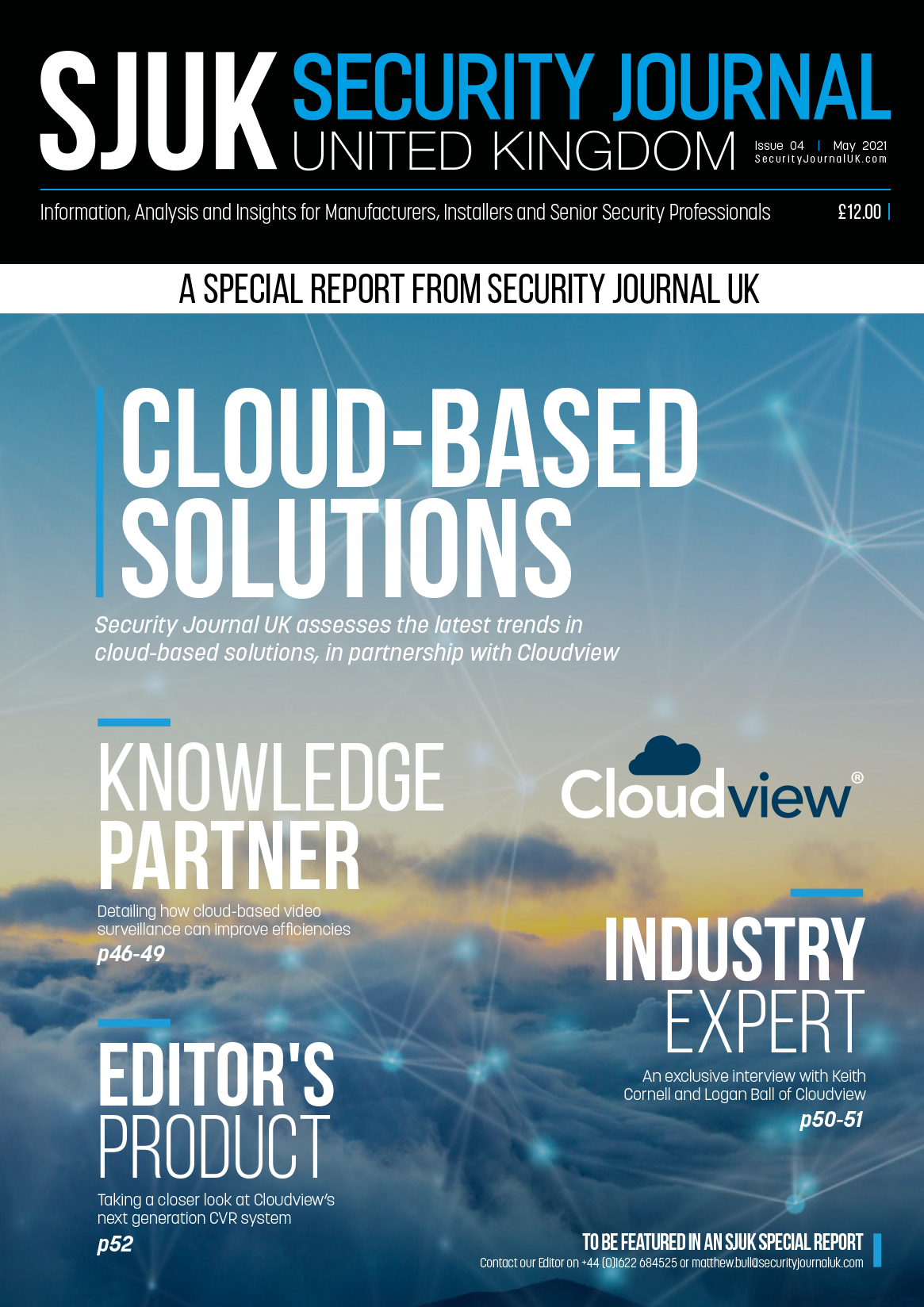
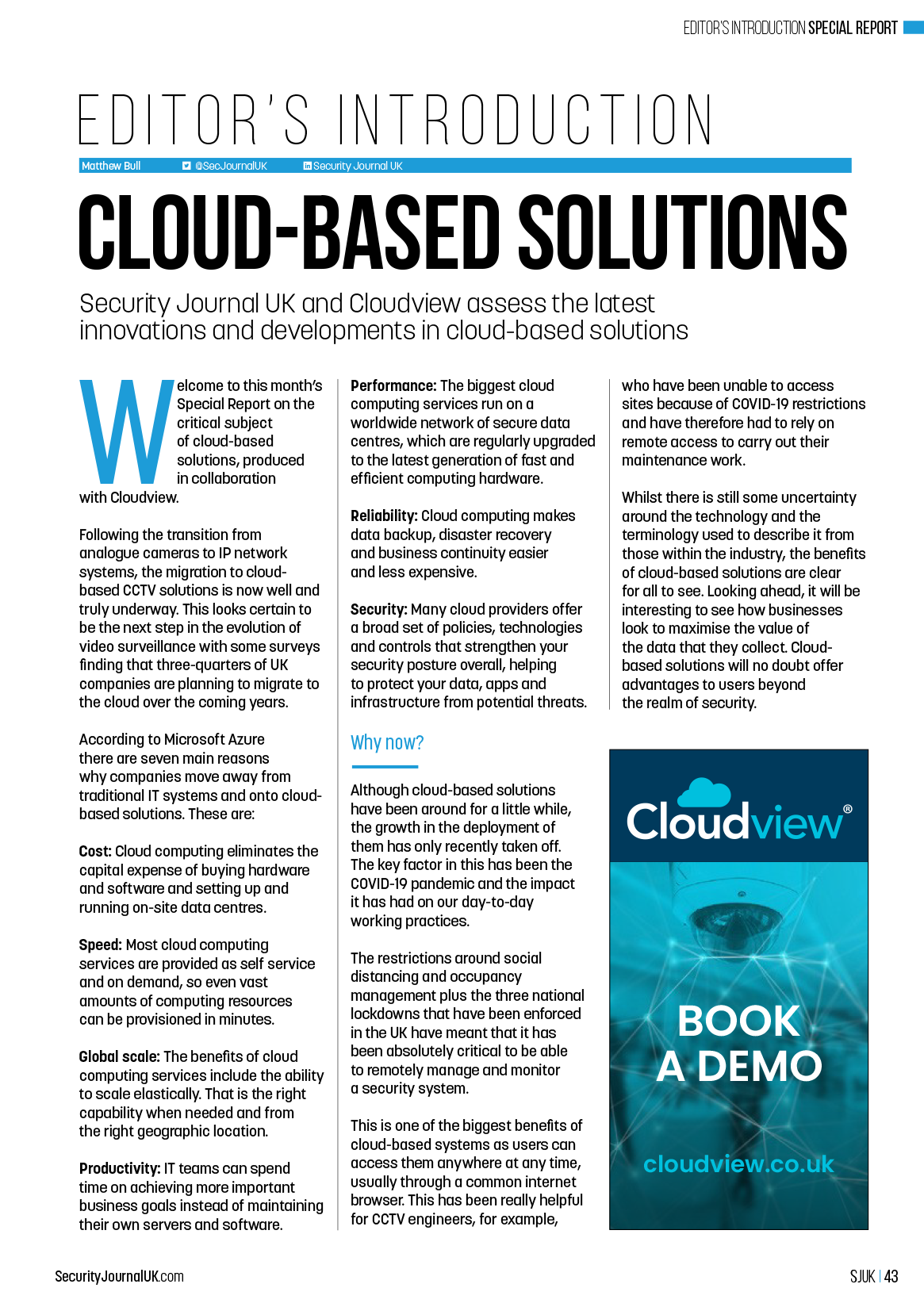
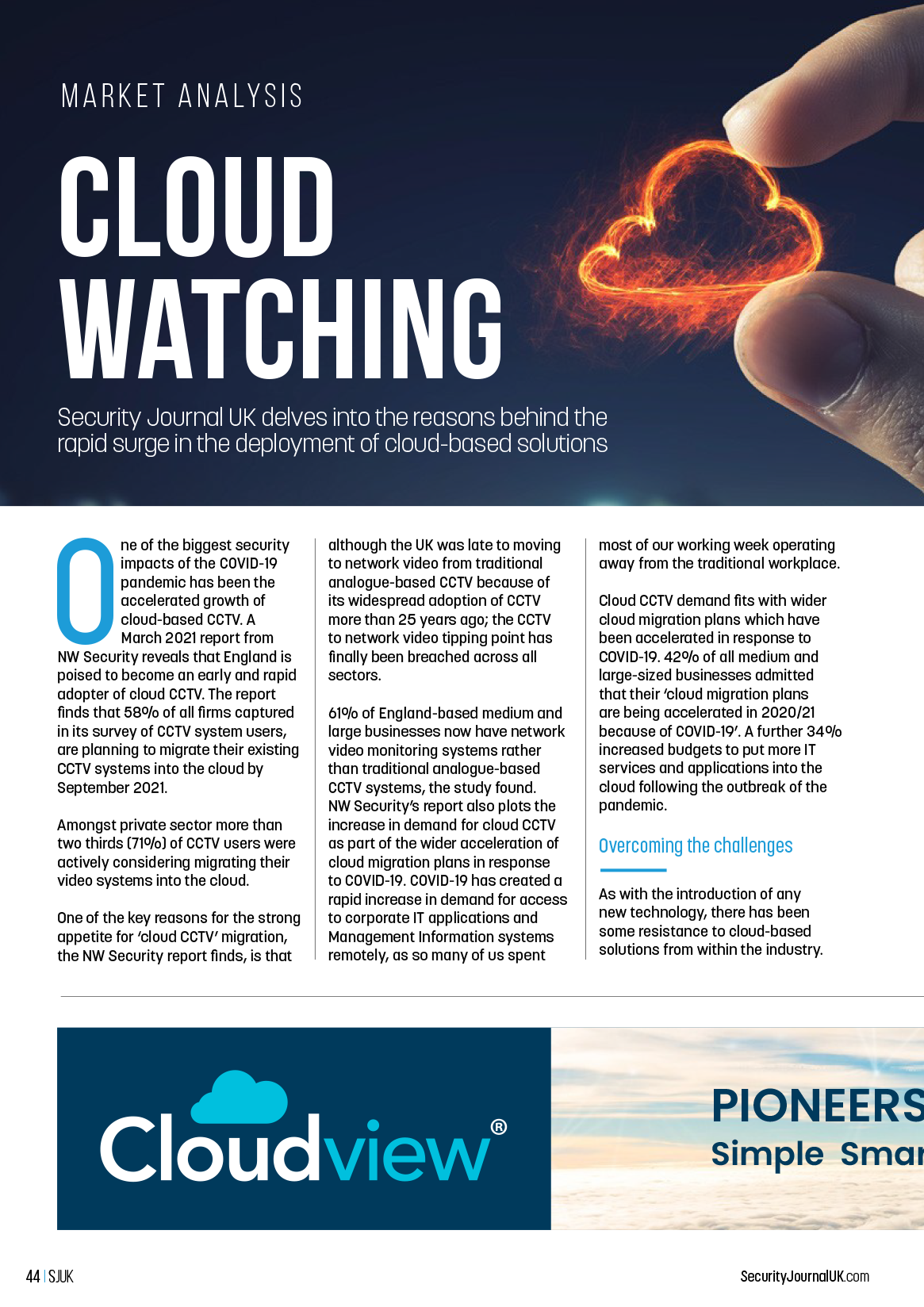

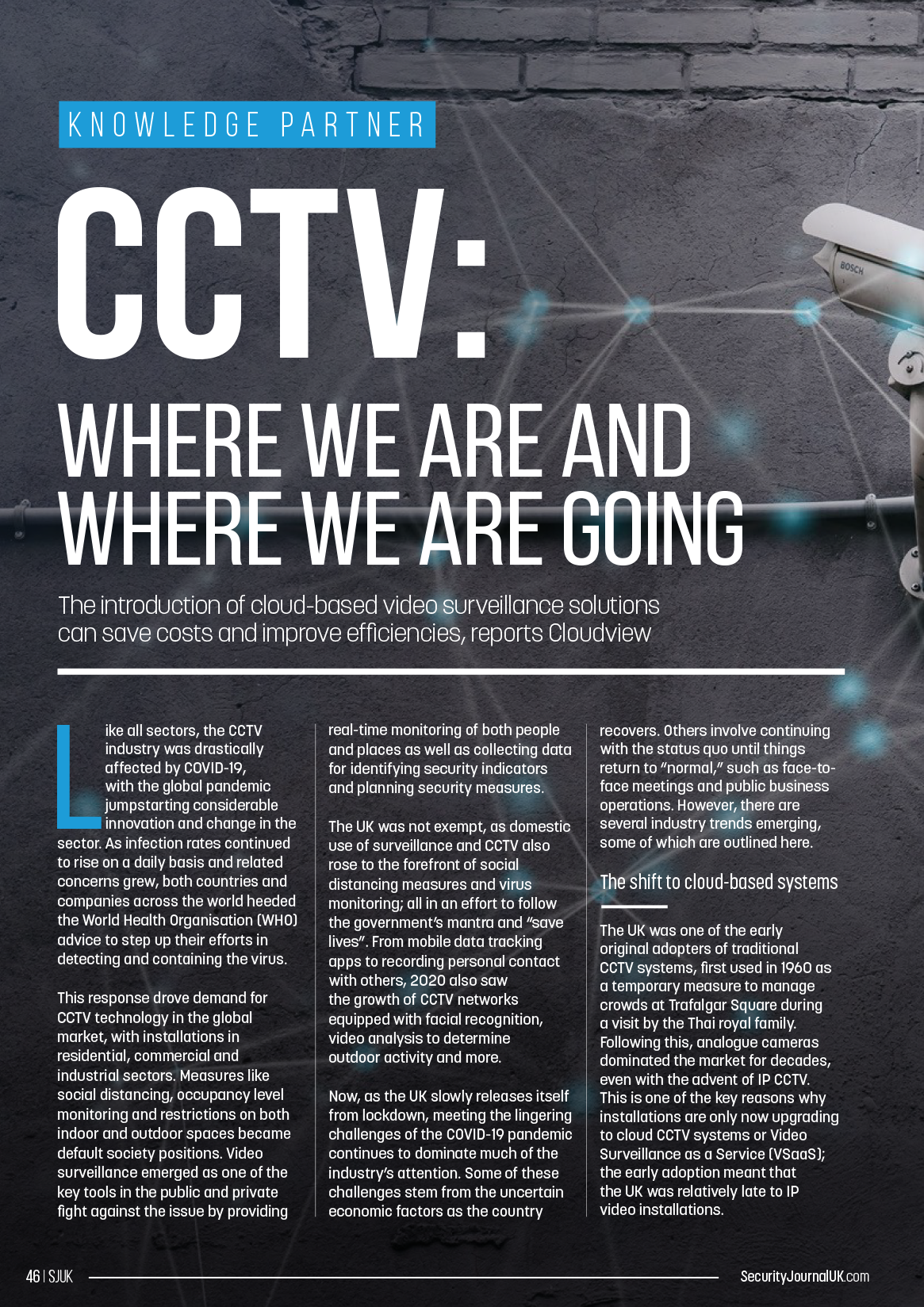
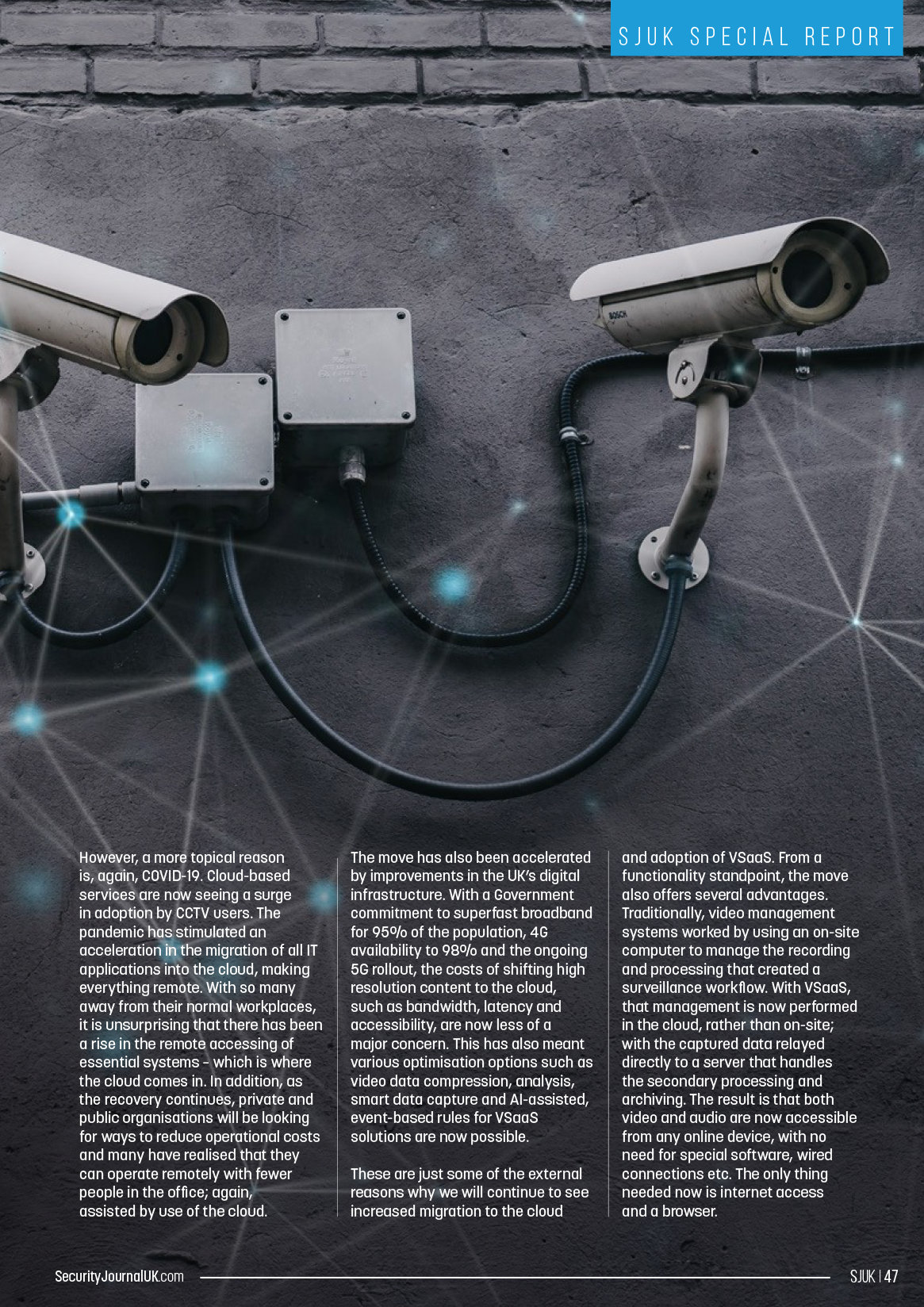
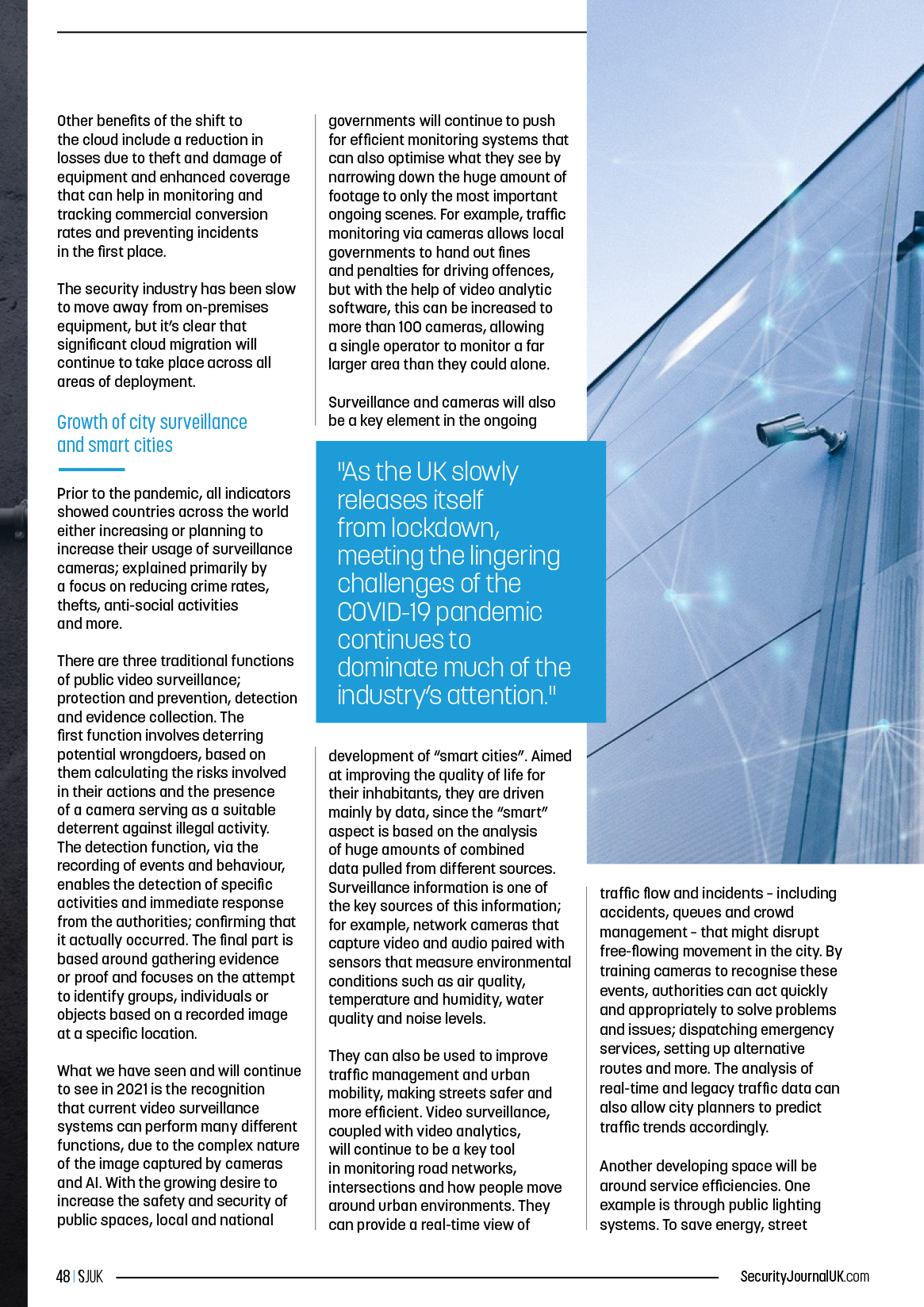
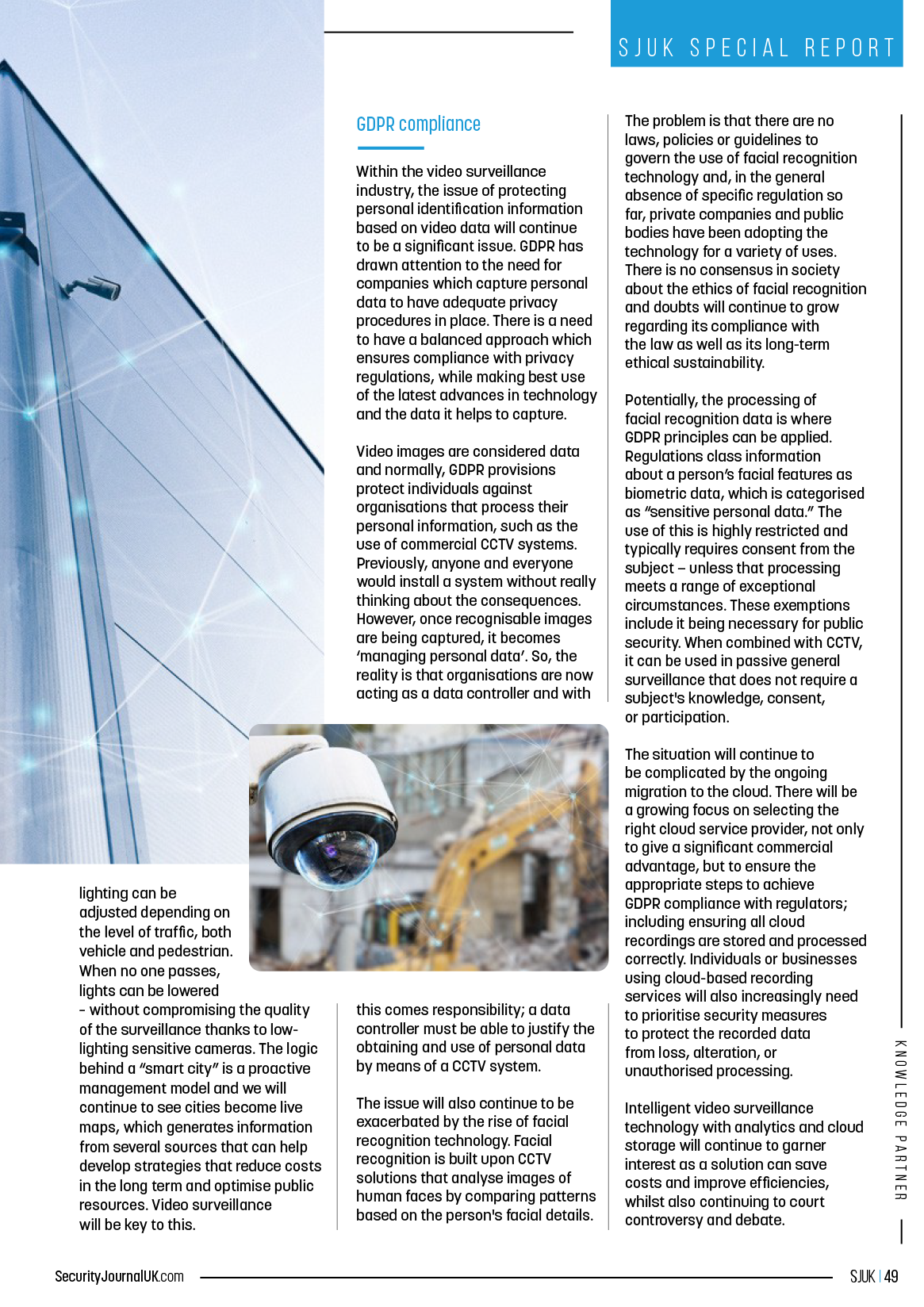
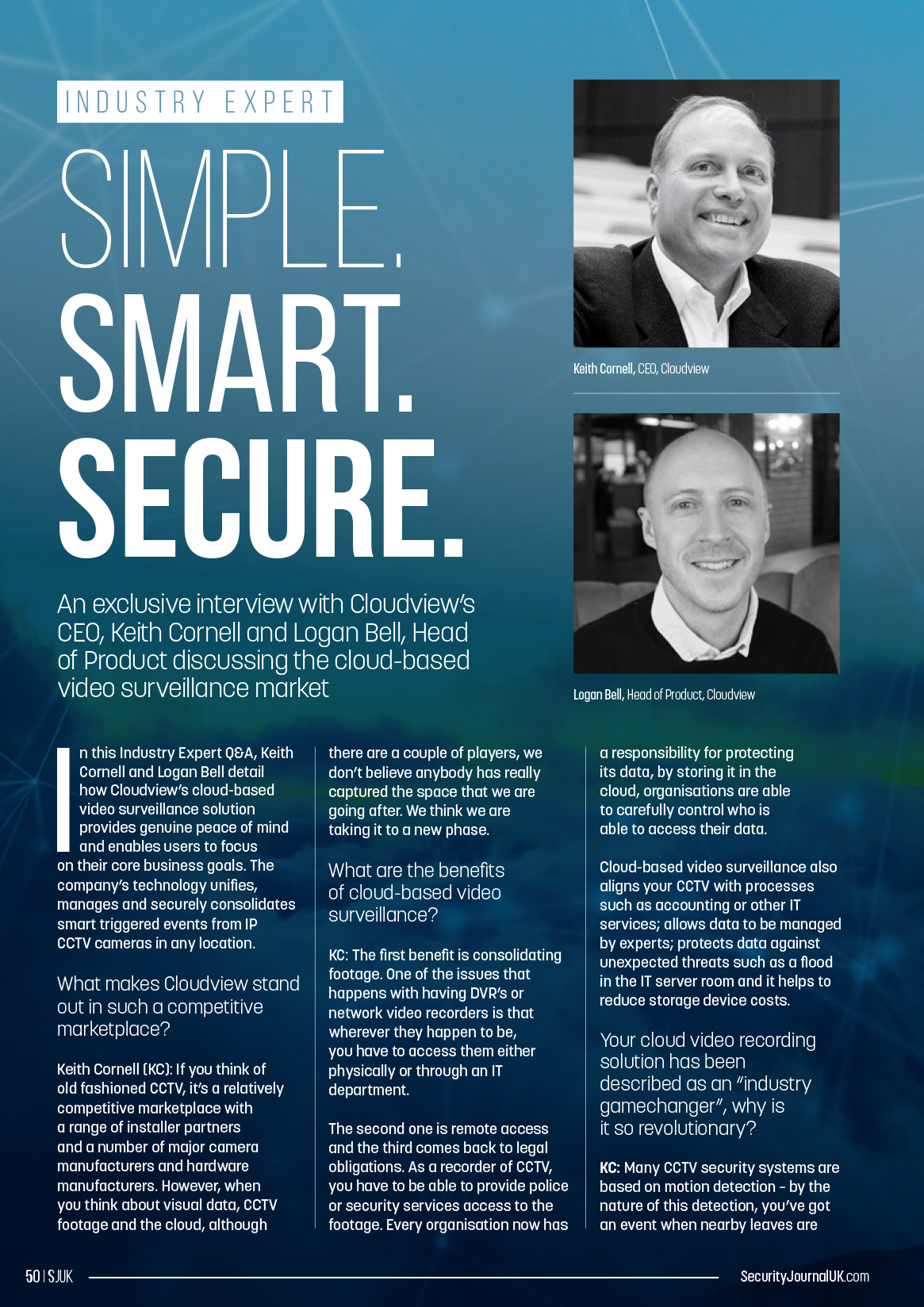
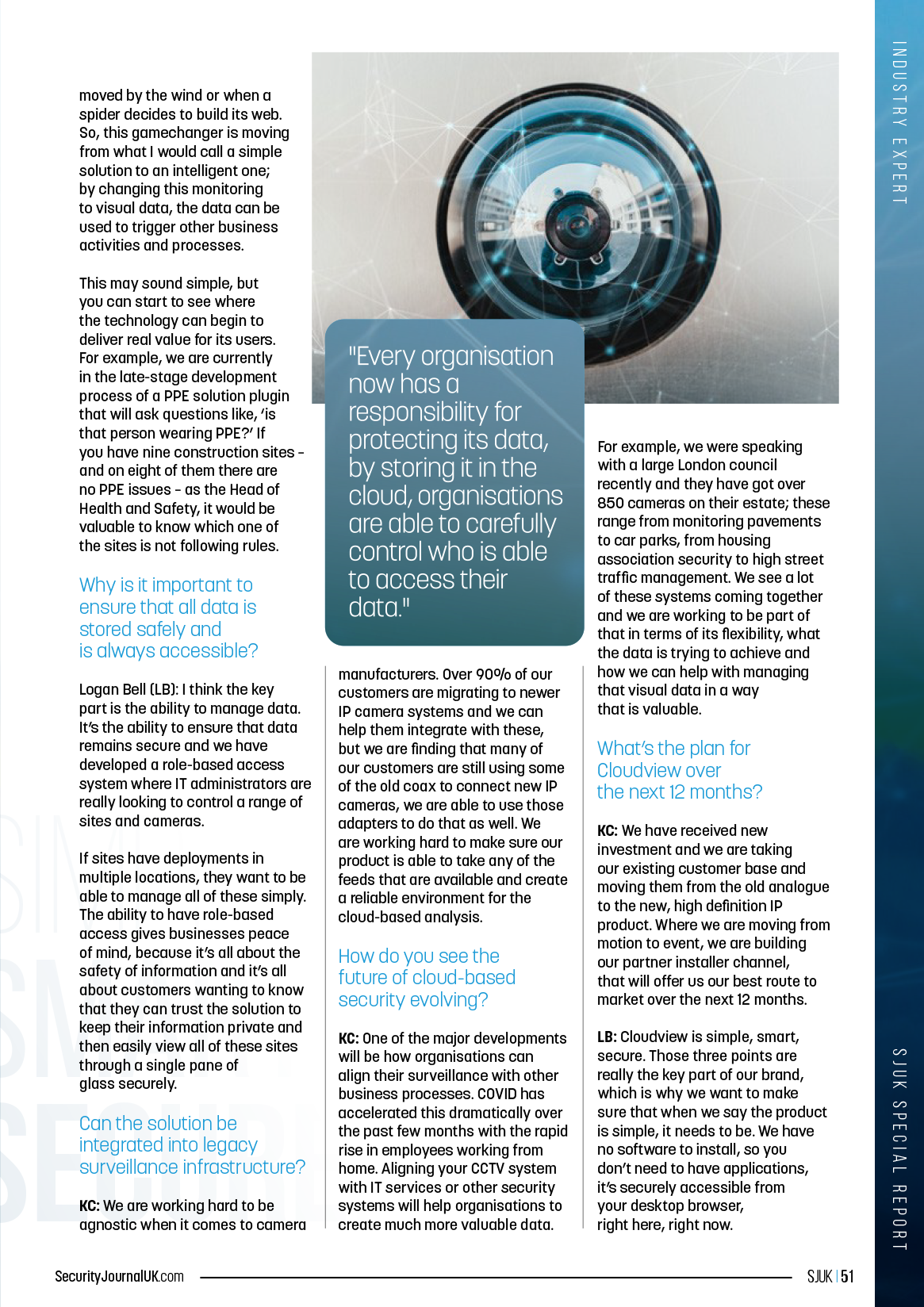

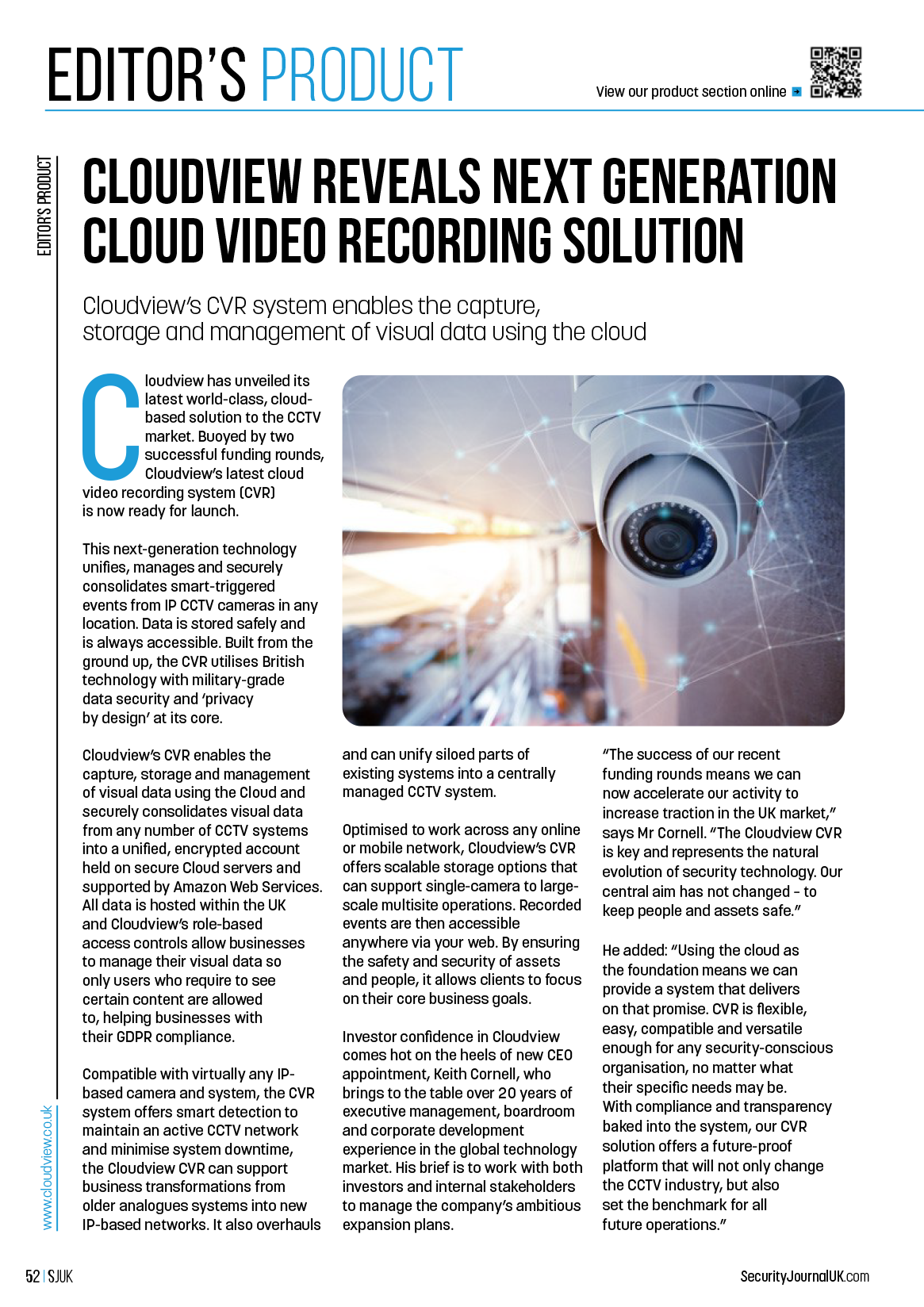

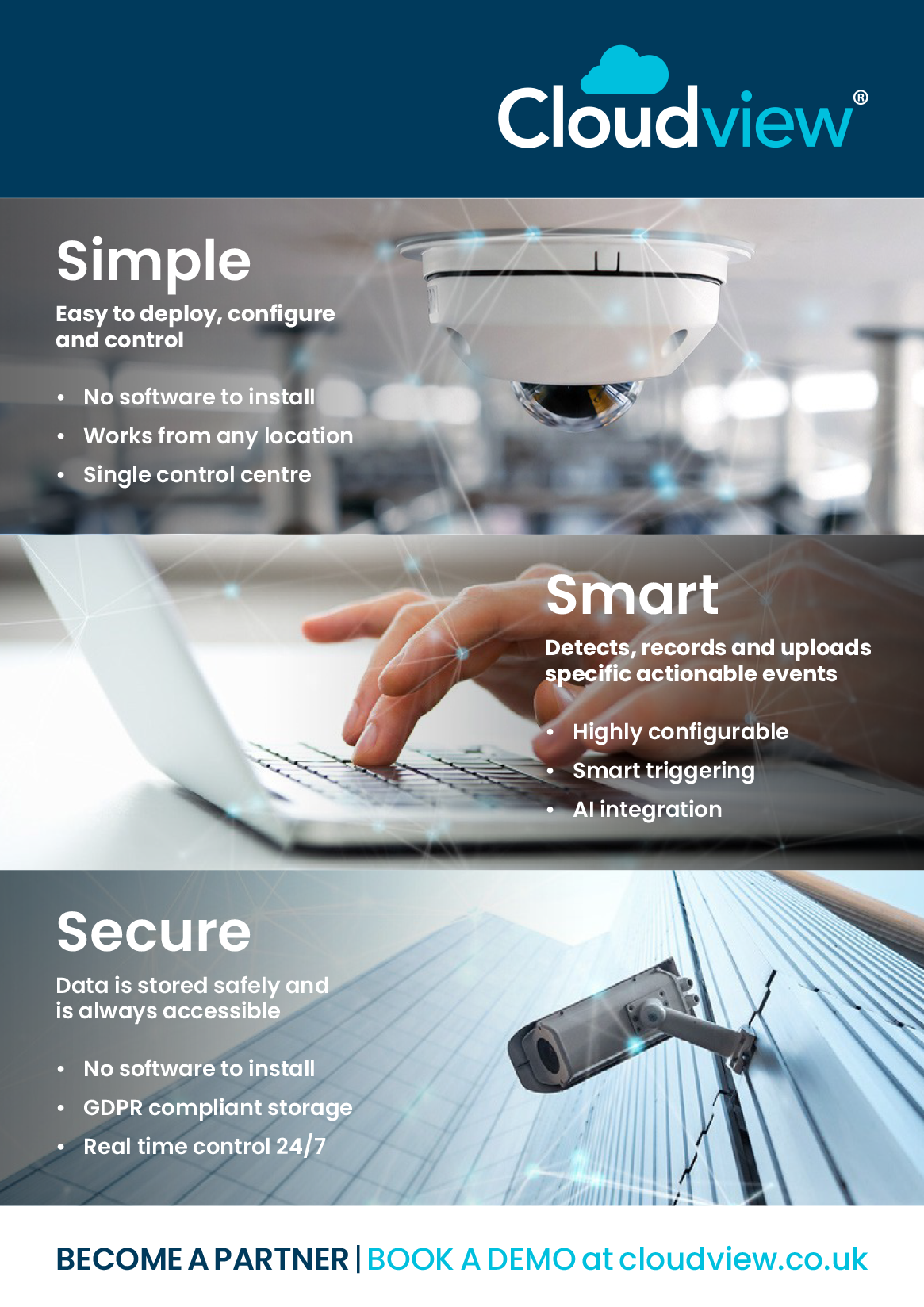
CLOUD-BASED SOLUTIONS
Security Journal UK and Cloudview assess the latest innovations and developments in cloud-based solutions
Welcome to this month’s Special Report on the critical subject of cloud-based solutions, produced in collaboration with Cloudview. Following the transition from analogue cameras to IP network systems, the migration to cloudbased CCTV solutions is now well and truly underway. This looks certain to be the next step in the evolution of video surveillance with some surveys finding that three-quarters of UK companies are planning to migrate to the cloud over the coming years.
According to Microsoft Azure there are seven main reasons why companies move away from traditional IT systems and onto cloudbased solutions. These are:
Cost: Cloud computing eliminates the capital expense of buying hardware and software and setting up and running on-site data centres.
Speed: Most cloud computing services are provided as self service and on demand, so even vast amounts of computing resources can be provisioned in minutes.
Global scale: The benefits of cloud computing services include the ability to scale elastically. That is the right capability when needed and from the right geographic location.
Productivity: IT teams can spend time on achieving more important business goals instead of maintaining their own servers and software.
Performance: The biggest cloud computing services run on a worldwide network of secure data centres, which are regularly upgraded to the latest generation of fast and efficient computing hardware.
Reliability: Cloud computing makes data backup, disaster recovery and business continuity easier and less expensive.
Security: Many cloud providers offer a broad set of policies, technologies and controls that strengthen your security posture overall, helping to protect your data, apps and infrastructure from potential threats.
Why now?
Although cloud-based solutions have been around for a little while, the growth in the deployment of them has only recently taken off.
The key factor in this has been the COVID-19 pandemic and the impact it has had on our day-to-day working practices.
The restrictions around social distancing and occupancy management plus the three national lockdowns that have been enforced in the UK have meant that it has been absolutely critical to be able to remotely manage and monitor a security system.
This is one of the biggest benefits of cloud-based systems as users can access them anywhere at any time, usually through a common internet browser. This has been really helpful for CCTV engineers, for example, who have been unable to access sites because of COVID-19 restrictions and have therefore had to rely on remote access to carry out their maintenance work.
Whilst there is still some uncertainty around the technology and the terminology used to describe it from those within the industry, the benefits of cloud-based solutions are clear for all to see. Looking ahead, it will be interesting to see how businesses look to maximise the value of the data that they collect. Cloudbased solutions will no doubt offer advantages to users beyond the realm of security.
One of the biggest security impacts of the COVID-19 pandemic has been the accelerated growth of cloud-based CCTV. A March 2021 report from NW Security reveals that England is poised to become an early and rapid adopter of cloud CCTV. The report finds that 58% of all firms captured in its survey of CCTV system users, are planning to migrate their existing CCTV systems into the cloud by September 2021.
Amongst private sector more than two thirds (71%) of CCTV users were actively considering migrating their video systems into the cloud.
One of the key reasons for the strong appetite for ‘cloud CCTV’ migration, the NW Security report finds, is that although the UK was late to moving to network video from traditional analogue-based CCTV because of its widespread adoption of CCTV more than 25 years ago; the CCTV to network video tipping point has finally been breached across all sectors.
61% of England-based medium and large businesses now have network video monitoring systems rather than traditional analogue-based CCTV systems, the study found. NW Security’s report also plots the increase in demand for cloud CCTV as part of the wider acceleration of cloud migration plans in response to COVID-19. COVID-19 has created a rapid increase in demand for access to corporate IT applications and Management Information systems remotely, as so many of us spent most of our working week operating away from the traditional workplace.
Cloud CCTV demand fits with wider cloud migration plans which have been accelerated in response to COVID-19. 42% of all medium and large-sized businesses admitted that their ‘cloud migration plans are being accelerated in 2020/21 because of COVID-19’. A further 34% increased budgets to put more IT services and applications into the cloud following the outbreak of the pandemic.
Overcoming the challenges
As with the introduction of any new technology, there has been some resistance to cloud-based solutions from within the industry.
Though it may seem rudimentary, the real challenge lies in defining the term. Many people are creating their own notion of what the cloud is, leading to the lack of a unified understanding of proper nomenclature. The word therefore becomes difficult to absorb in an industry where individuals commonly talk about physical devices (and terms) that are so widely known, such as surveillance cameras.
Overcoming this challenge starts with transforming the mindset from physical security to solving risk-based problems. By understanding the risks to an organisation, providers can become practitioners of risk-based outcomes rather than technology-based outcomes. Cloud infrastructure is made up of more than just devices; it encompasses the people, processes and technology applications that are required to enable organisations to accomplish their business and security goals.
Providing valuable data
Cloud technology makes life easier for security and business professionals. Various types of systems and data can be incorporated within a single platform, such as video surveillance, access control and analytics and displayed in a user-friendly fashion.
"One of the major developments will be how organisations can align their surveillance with other business processes."
With features such as reduced setup time and efficient customisation, the cloud’s intuitiveness can benefit businesses in more ways than one.
The cloud also provides a level of data security that isn’t easily achieved with on-premises solutions. Cloud-based platforms benefit from ongoing updates to not only features, but also vulnerabilities that have been identified and these updates are rolled out almost instantaneously, ensuring that the data being collected, transmitted and stored via the cloud is as safe and secure as possible. Similarly, in cloud-based platforms that utilise the public cloud, the security protocols that are in place for these data centres also apply to the data being stored, which means cybersecurity is top of mind.
Keith Cornell, CEO of Cloudview believes that maximising the value of this data for business intelligence purposes will be the next significant innovation within cloud-based security. He said: “One of the major developments will be how organisations can align their surveillance with other business processes. COVID has accelerated this dramatically over the past few months with the rapid rise in employees working from home. Aligning your CCTV system with IT services or other security systems will help organisations to create much more valuable data.”
“For example, we were speaking with a large London council recently and they have got over 850 cameras on their estate; these range from monitoring pavements to car parks, from housing association security to high street traffic management. We see a lot of these systems coming together and we are working to be part of that in terms of its flexibility, what the data is trying to achieve and how we can help with managing that visual data in a way that is valuable.”
The transition from network CCTV systems to cloud-based solutions is now well and truly underway, it’s time to get your head in the cloud.
Security Journal UK and Cloudview assess the latest innovations and developments in cloud-based solutions
Like all sectors, the CCTV industry was drastically affected by COVID-19, with the global pandemic jumpstarting considerable innovation and change in the sector. As infection rates continued to rise on a daily basis and related concerns grew, both countries and companies across the world heeded the World Health Organisation (WHO) advice to step up their efforts in detecting and containing the virus.
This response drove demand for CCTV technology in the global market, with installations in residential, commercial and industrial sectors. Measures like social distancing, occupancy level monitoring and restrictions on both indoor and outdoor spaces became default society positions. Video surveillance emerged as one of the key tools in the public and private fight against the issue by providing real-time monitoring of both people and places as well as collecting data for identifying security indicators and planning security measures.
The UK was not exempt, as domestic use of surveillance and CCTV also rose to the forefront of social distancing measures and virus monitoring; all in an effort to follow the government’s mantra and “save lives”. From mobile data tracking apps to recording personal contact with others, 2020 also saw the growth of CCTV networks equipped with facial recognition, video analysis to determine outdoor activity and more.
Now, as the UK slowly releases itself from lockdown, meeting the lingering challenges of the COVID-19 pandemic continues to dominate much of the industry’s attention. Some of these challenges stem from the uncertain economic factors as the country recovers. Others involve continuing with the status quo until things return to “normal,” such as face-to-face meetings and public business operations. However, there are several industry trends emerging, some of which are outlined here.
The shift to cloud-based systems
The UK was one of the early original adopters of traditional CCTV systems, first used in 1960 as a temporary measure to manage crowds at Trafalgar Square during a visit by the Thai royal family. Following this, analogue cameras dominated the market for decades, even with the advent of IP CCTV. This is one of the key reasons why installations are only now upgrading to cloud CCTV systems or Video Surveillance as a Service (VSaaS); the early adoption meant that the UK was relatively late to IP video installations.
However, a more topical reason is, again, COVID-19. Cloud-based services are now seeing a surge in adoption by CCTV users. The pandemic has stimulated an acceleration in the migration of all IT applications into the cloud, making everything remote. With so many away from their normal workplaces, it is unsurprising that there has been a rise in the remote accessing of essential systems – which is where the cloud comes in. In addition, as the recovery continues, private and public organisations will be looking for ways to reduce operational costs and many have realised that they can operate remotely with fewer people in the office; again, assisted by use of the cloud.
The move has also been accelerated by improvements in the UK’s digital infrastructure. With a Government commitment to superfast broadband for 95% of the population, 4G availability to 98% and the ongoing 5G rollout, the costs of shifting high resolution content to the cloud, such as bandwidth, latency and accessibility, are now less of a major concern. This has also meant various optimisation options such as video data compression, analysis, smart data capture and AI-assisted, event-based rules for VSaaS solutions are now possible.
These are just some of the external reasons why we will continue to see increased migration to the cloud and adoption of VSaaS. From a functionality standpoint, the move also offers several advantages. Traditionally, video management systems worked by using an on-site computer to manage the recording and processing that created a surveillance workflow. With VSaaS, that management is now performed in the cloud, rather than on-site; with the captured data relayed directly to a server that handles the secondary processing and archiving. The result is that both video and audio are now accessible from any online device, with no need for special software, wired connections etc. The only thing needed now is internet access and a browser.
Other benefits of the shift to the cloud include a reduction in losses due to theft and damage of equipment and enhanced coverage that can help in monitoring and tracking commercial conversion rates and preventing incidents in the first place.
The security industry has been slow to move away from on-premises equipment, but it’s clear that significant cloud migration will continue to take place across all areas of deployment. Growth of city surveillance and smart cities
Prior to the pandemic, all indicators showed countries across the world either increasing or planning to increase their usage of surveillance cameras; explained primarily by a focus on reducing crime rates, thefts, anti-social activities and more.
There are three traditional functions of public video surveillance; protection and prevention, detection and evidence collection. The first function involves deterring potential wrongdoers, based on them calculating the risks involved in their actions and the presence of a camera serving as a suitable deterrent against illegal activity. The detection function, via the recording of events and behaviour, enables the detection of specific activities and immediate response from the authorities; confirming that it actually occurred. The final part is based around gathering evidence or proof and focuses on the attempt to identify groups, individuals or objects based on a recorded image at a specific location.
What we have seen and will continue to see in 2021 is the recognition that current video surveillance systems can perform many different functions, due to the complex nature of the image captured by cameras and AI. With the growing desire to increase the safety and security of public spaces, local and national governments will continue to push for efficient monitoring systems that can also optimise what they see by narrowing down the huge amount of footage to only the most important ongoing scenes. For example, traffic monitoring via cameras allows local governments to hand out fines and penalties for driving offences, but with the help of video analytic software, this can be increased to more than 100 cameras, allowing a single operator to monitor a far larger area than they could alone.
"As the UK slowly releases itself from lockdown, meeting the lingering challenges of the COVID-19 pandemic continues to dominate much of the industry’s attention."
Surveillance and cameras will also be a key element in the ongoing development of “smart cities”. Aimed at improving the quality of life for their inhabitants, they are driven mainly by data, since the “smart” aspect is based on the analysis of huge amounts of combined data pulled from different sources. Surveillance information is one of the key sources of this information; for example, network cameras that capture video and audio paired with sensors that measure environmental conditions such as air quality, temperature and humidity, water quality and noise levels.
They can also be used to improve traffic management and urban mobility, making streets safer and more efficient. Video surveillance, coupled with video analytics, will continue to be a key tool in monitoring road networks, intersections and how people move around urban environments. They can provide a real-time view of traffic flow and incidents – including accidents, queues and crowd management – that might disrupt free-flowing movement in the city. By training cameras to recognise these events, authorities can act quickly and appropriately to solve problems and issues; dispatching emergency services, setting up alternative routes and more. The analysis of real-time and legacy traffic data can also allow city planners to predict traffic trends accordingly.
Another developing space will be around service efficiencies. One example is through public lighting systems. To save energy, street lighting can be adjusted depending on the level of traffic, both vehicle and pedestrian. When no one passes, lights can be lowered – without compromising the quality of the surveillance thanks to low-lighting sensitive cameras. The logic behind a “smart city” is a proactive management model and we will continue to see cities become live maps, which generates information from several sources that can help develop strategies that reduce costs in the long term and optimise public resources. Video surveillance will be key to this.
GDPR compliance
Within the video surveillance industry, the issue of protecting personal identification information based on video data will continue to be a significant issue. GDPR has drawn attention to the need for companies which capture personal data to have adequate privacy procedures in place. There is a need to have a balanced approach which ensures compliance with privacy regulations, while making best use of the latest advances in technology and the data it helps to capture.
Video images are considered data and normally, GDPR provisions protect individuals against organisations that process their personal information, such as the use of commercial CCTV systems. Previously, anyone and everyone would install a system without really thinking about the consequences. However, once recognisable images are being captured, it becomes ‘managing personal data’. So, the reality is that organisations are now acting as a data controller and with this comes responsibility; a data controller must be able to justify the obtaining and use of personal data by means of a CCTV system.
The issue will also continue to be exacerbated by the rise of facial recognition technology. Facial recognition is built upon CCTV solutions that analyse images of human faces by comparing patterns based on the person's facial details.
The problem is that there are no laws, policies or guidelines to govern the use of facial recognition technology and, in the general absence of specific regulation so far, private companies and public bodies have been adopting the technology for a variety of uses. There is no consensus in society about the ethics of facial recognition and doubts will continue to grow regarding its compliance with the law as well as its long-term ethical sustainability.
Potentially, the processing of facial recognition data is where GDPR principles can be applied. Regulations class information about a person’s facial features as biometric data, which is categorised as “sensitive personal data.” The use of this is highly restricted and typically requires consent from the subject — unless that processing meets a range of exceptional circumstances. These exemptions include it being necessary for public security. When combined with CCTV, it can be used in passive general surveillance that does not require a subject's knowledge, consent, or participation.
The situation will continue to be complicated by the ongoing migration to the cloud. There will be a growing focus on selecting the right cloud service provider, not only to give a significant commercial advantage, but to ensure the appropriate steps to achieve GDPR compliance with regulators; including ensuring all cloud recordings are stored and processed correctly. Individuals or businesses using cloud-based recording services will also increasingly need to prioritise security measures to protect the recorded data from loss, alteration, or unauthorised processing.
Intelligent video surveillance technology with analytics and cloud storage will continue to garner interest as a solution can save costs and improve efficiencies, whilst also continuing to court controversy and debate.
SIMPLE, SMART, SECURE
An exclusive interview with Cloudview’s CEO, Keith Cornell and Logan Bell, Head of Product discussing the cloud-based video surveillance market
In this Industry Expert Q&A, Keith Cornell and Logan Bell detail how Cloudview’s cloud-based video surveillance solution provides genuine peace of mind and enables users to focus on their core business goals. The company’s technology unifies, manages and securely consolidates smart triggered events from IP CCTV cameras in any location.
What makes Cloudview stand out in such a competitive marketplace?
Keith Cornell (KC): If you think of old fashioned CCTV, it’s a relatively competitive marketplace with a range of installer partners and a number of major camera manufacturers and hardware manufacturers. However, when you think about visual data, CCTV footage and the cloud, although there are a couple of players, we don’t believe anybody has really captured the space that we are going after. We think we are taking it to a new phase.
What are the benefits of cloud-based video surveillance?
KC: The first benefit is consolidating footage. One of the issues that happens with having DVR’s or network video recorders is that wherever they happen to be, you have to access them either physically or through an IT department.
The second one is remote access and the third comes back to legal obligations. As a recorder of CCTV, you have to be able to provide police or security services access to the footage. Every organisation now has a responsibility for protecting its data, by storing it in the cloud, organisations are able to carefully control who is able to access their data.
Cloud-based video surveillance also aligns your CCTV with processes such as accounting or other IT services; allows data to be managed by experts; protects data against unexpected threats such as a flood in the IT server room and it helps to reduce storage device costs.
Your cloud video recording solution has been described as an “industry game changer”, why is it so revolutionary?
KC: Many CCTV security systems are based on motion detection – by the nature of this detection, you’ve got moved by the wind or when a
spider decides to build its web. So, this game changer is moving from what I would call a simple solution to an intelligent one; by changing this monitoring to visual data, the data can be used to trigger other business activities and processes.
This may sound simple, but you can start to see where the technology can begin to deliver real value for its users. For example, we are currently in the late-stage development process of a PPE solution plugin that will ask questions like, ‘is that person wearing PPE?’ If you have nine construction sites – and on eight of them there are no PPE issues – as the Head of Health and Safety, it would be valuable to know which one of the sites is not following rules.
Why is it important to ensure that all data is stored safely and is always accessible?
Logan Bell (LB): I think the key part is the ability to manage data. It’s the ability to ensure that data remains secure and we have developed a role-based access system where IT administrators are really looking to control a range of sites and cameras.
If sites have deployments in multiple locations, they want to be able to manage all of these simply. The ability to have role-based access gives businesses peace of mind, because it’s all about the safety of information and it’s all about customers wanting to know that they can trust the solution to keep their information private and then easily view all of these sites through a single pane of glass securely.
Can the solution be integrated into legacy surveillance infrastructure?
KC: We are working hard to be agnostic when it comes to camera manufacturers. Over 90% of our customers are migrating to newer IP camera systems and we can help them integrate with these, but we are finding that many of our customers are still using some of the old coax to connect new IP cameras, we are able to use those adapters to do that as well. We are working hard to make sure our product is able to take any of the feeds that are available and create a reliable environment for the cloud-based analysis.
How do you see the future of cloud-based security evolving?
KC: One of the major developments will be how organisations can align their surveillance with other business processes. COVID has accelerated this dramatically over the past few months with the rapid rise in employees working from home. Aligning your CCTV system with IT services or other security systems will help organisations to create much more valuable data.
For example, we were speaking with a large London council recently and they have got over 850 cameras on their estate; these range from monitoring pavements to car parks, from housing association security to high street traffic management. We see a lot of these systems coming together and we are working to be part of that in terms of its flexibility, what the data is trying to achieve and how we can help with managing that visual data in a way that is valuable.
What’s the plan for Cloudview over the next 12 months?
KC: We have received new investment and we are taking our existing customer base and moving them from the old analogue to the new, high definition IP product. Where we are moving from motion to event, we are building our partner installer channel, that will offer us our best route to market over the next 12 months.
LB: Cloudview is simple, smart, secure. Those three points are really the key part of our brand, which is why we want to make sure that when we say the product is simple, it needs to be. We have no software to install, so you don’t need to have applications, it’s securely accessible from your desktop browser, right here, right now.
Cloudview’s CVR system enables the capture, storage and management of visual data using the cloud
Cloudview has unveiled its latest world-class, cloud-based solution to the CCTV market. Buoyed by two successful funding rounds, Cloudview’s latest cloud video recording system (CVR) is now ready for launch.
This next-generation technology unifies, manages and securely consolidates smart-triggered events from IP CCTV cameras in any location. Data is stored safely and is always accessible. Built from the ground up, the CVR utilises British technology with military-grade data security and ‘privacy by design’ at its core.
Cloudview’s CVR enables the capture, storage and management of visual data using the Cloud and securely consolidates visual data from any number of CCTV systems into a unified, encrypted account held on secure Cloud servers and supported by Amazon Web Services.
All data is hosted within the UK and Cloudview’s role-based access controls allow businesses to manage their visual data so only users who require to see certain content are allowed to, helping businesses with their GDPR compliance.
Compatible with virtually any IP-based camera and system, the CVR system offers smart detection to maintain an active CCTV network and minimise system downtime, the Cloudview CVR can support business transformations from older analogues systems into new IP-based networks. It also overhaulsand can unify siloed parts of existing systems into a centrally managed CCTV system.
Optimised to work across any online or mobile network, Cloudview’s CVR offers scalable storage options that can support single-camera to large-scale multisite operations. Recorded events are then accessible anywhere via your web. By ensuring the safety and security of assets and people, it allows clients to focus on their core business goals.
Investor confidence in Cloudview comes hot on the heels of new CEO appointment, Keith Cornell, who brings to the table over 20 years of executive management, boardroom and corporate development experience in the global technology market. His brief is to work with both investors and internal stakeholders to manage the company’s ambitious expansion plans.
“The success of our recent funding rounds means we can now accelerate our activity to increase traction in the UK market,” says Mr Cornell. “The Cloudview CVR is key and represents the natural evolution of security technology. Our central aim has not changed – to keep people and assets safe.”
He added: “Using the cloud as the foundation means we can provide a system that delivers on that promise. CVR is flexible, easy, compatible and versatile enough for any security-conscious organisation, no matter what their specific needs may be. With compliance and transparency baked into the system, our CVR solution offers a future-proof platform that will not only change the CCTV industry, but also set the benchmark for all future operations.”
Find out more - Our Technology

